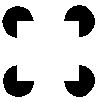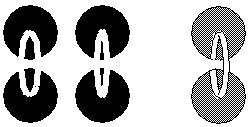Plato's Cave: Evidence for Completion in Depth
Evidence for Boundary and Surface Completion in Depth
If it is accepted that boundary completion and surface brightness
filling-in occur by way of spatial diffusion, then the following
evidence suggests that these mechanisms must occur not only in the
plane of the visual field, but also in depth.
First is the evidence of the Kanizsa figure itself, which is reported
by subjects to appear to hover or float some
distance above the page.

More direct evidence is provided by the three-dimensional Kanizsa
figure shown below, to be viewed binocularly, i.e. the left eye to
view the left frame while the right eye views the right frame.

For those of you who cannot "free fuse" such stereo pairs, the sketch
to the right illustrates how the percept looks. Equally interesting
is the "porthole illusion" shown below, where the left and right eye
images have been reversed, resulting in a percept as shown to the
right, i.e. a white square viewed through four "portholes", where the
inner rim of the portholes are completed perceptually in the same
manner as the edges of the square were above.

Another neat example is this one, again a stereo pair, the percept is
shown at the right. In this one we see boundary and surface
completion around the ring going straight in to the paper.

Further evidence for three-dimensional completion is presented by Rock
& Brosgole (1964). ...
Return to argument
Return to Steve Lehar




